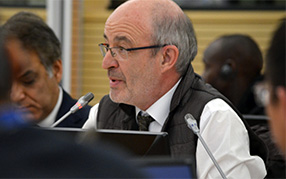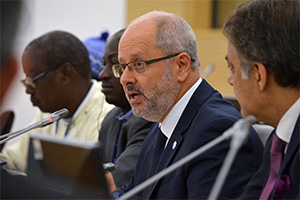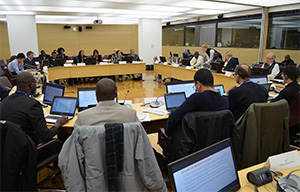World Agricultures Watch targets end to “one size fits all” agricultural development

With the world needing to provide roughly 50 percent more food by 2050 – even as climate change, land degradation, watery scarcity and other challenges threaten productivity – it is clear that agricultural systems must transform.
The problem is that no “one size fits all solution” exists, despite current policy designs often functioning as if this were the case – often without any clear information on the different types of agriculture that exist within a country.
World Agricultures Watch (WAW) – managed by the Food and Agriculture Organization of the United Nations (FAO) and the International Fund for Agricultural Development (IFAD), and backed by France – is well on the road to providing the missing information to better inform policy design.
Representatives of farming organizations and governments from partner countries El Salvador, Madagascar, Niger, Senegal, Tunisia and Viet Nam this week met at the IFAD headquarters in Rome to present their initial WAW work, and chart the best way forward to use the information and to lift farmers out of poverty.
 “World Agricultures Watch is important because agriculture is changing; we need to understand the diversity of the types of agriculture and the transformations they are undergoing,” said Pierre-Marie Bosc, coordinator of WAW.
“World Agricultures Watch is important because agriculture is changing; we need to understand the diversity of the types of agriculture and the transformations they are undergoing,” said Pierre-Marie Bosc, coordinator of WAW.
The early results from the pilot countries show real promise for the future of the initiative, demonstrating that the approach can shed light on the make-up of agriculture in nations across the globe.
In Madagascar, for example, the Network for Rural Observatories found that very small holdings of under 0.75 hectares make up 60 percent of farms at national level, with rice-growing the most common form of agriculture practiced.
“We were better able to categorize agriculture in Madagascar because of the results we obtained,” said Nirina Rabevohitra from the network. “The analysis conducted within the WAW initiative really facilitated the debate with … the prime minister’s and president’s office, and the agricultural ministry.”
In El Salvador, the ministry of agriculture noted different farming models in the country, which operate differently and lead to diverse ways of making a living.
Some 2.3 per cent of family farmers have relatively high income in El Salvador, with about $1600 dollars a month in disposable income to spend on their families or reinvest in their farms. At the other end of the spectrum, many farmers live on a pittance. Some make as little as $20 a month, meaning they rely on remittances or finding additional work outside of their farms.
“What we have done is really worthwhile, but we still need to conduct more exercises and focus our studies on specific areas,” said Yessica Sanchez Abrego, from the El Salvador ministry of agriculture.
According to Pierre-Marie, the results from Senegal are particularly encouraging, showing exactly how and where to support farmers.
“In southern Senegal, the data shows that people who diversified from the usual rain-fed crops into horticulture, raising small stock or producing fruit are better off,” he said. “It doesn’t take a lot of investment to move to high-value crops, but these investments are crucial to escape poverty.”
 This is an important point for Eduardo Mansur, the director of FAO’s Land and Water division, who sees the need for diversification and agricultural approaches appropriate to local conditions as crucial in the transformation of systems.
This is an important point for Eduardo Mansur, the director of FAO’s Land and Water division, who sees the need for diversification and agricultural approaches appropriate to local conditions as crucial in the transformation of systems.
“We need to know what works and where,” he said. “If cash crops, or raising livestock, is what works and makes money to lift farmers out of poverty, this is what we need to look at. World Agricultures Watch is providing us with this information, and can do a lot more with the right support.”
WAW is refining its data collection methodology and looking to connect separate information systems that document, on one side, the assets of the farmers and on the other their performance. This will help create the tailored policies needed to target particularly small farmers and allow them to make a decent living out of their activities.
This is also important with regards to rural-urban migration, since there are currently few prospects for rural youth. In the future, more land might become uncultivated due to urbanization, which further challenges attempts to raise food production.
The data collected can already be used to inform not just governments, but farmers themselves so they can look at how to use the results to escape the poverty trap.
 “It’s important we give families good information so they can improve their productivity,” said Nadjirou Sall, from the West Africa Network of Farmers and Agricultural Producers (ROPPA).
“It’s important we give families good information so they can improve their productivity,” said Nadjirou Sall, from the West Africa Network of Farmers and Agricultural Producers (ROPPA).
Gérard Andriamandimby, from Madagascar’s Union of Agricultural Organizations, believes that this is one of the key steps WAW must take next to make it a success.
“The results of these studies have to serve as a political base … [but] if there is no connection between the results and the people on the ground, we aren’t going to evolve in the implementation of this work,” he said.
Pierre-Marie agrees that information has to be “useful for farmers to better understand how they can make their assets more productive, more sustainable and finally to come out of poverty”. But he also sees a huge advantage in WAW in terms of getting information to farmers faster.
“We have agriculture censuses sometimes every ten years; you get the first results three of four years later,” he said. “There is a huge gap between when you get the data and when you can use it. Three of four years for people living in poverty? This is not possible.”
More on the World Agricultures Watch >>
View the Photo Gallery from the Workshop >>
